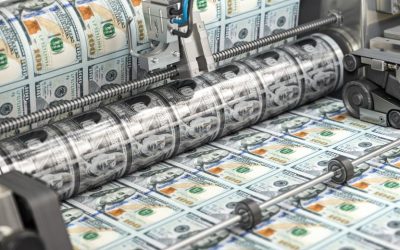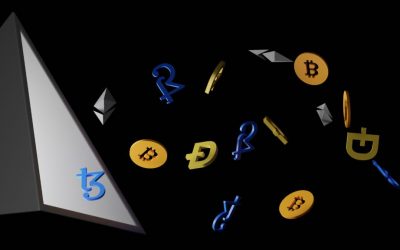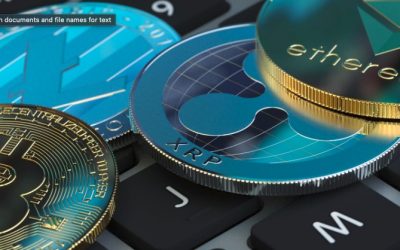Fiat currencies are simply an idea. They portray the idea of an asset that governments and Central Banks have impressed on societies to believe as good value. In reality, Fiat currencies have zero intrinsic value other than the piece of paper or metal coins they are made of.
We are all well accustomed to traditional currencies such as the United States Dollar (USD) , the British Pound (GBP), the Euro (EUR) and many other currency denominations but it’s rather likely most people don’t know these currencies are referred to as “Fiat” money, or “Fiat” currency.
What does “Fiat” mean?
The word “fiat” comes from Latin and refers to an arbitrary order issued by a government or other authoritative body, for instance, a Central Bank.
As applied to money, “fiat currencies” simply mean an asset that has been declared as legitimate and legal tender by a government or a central bank as is the case with the United States Dollar (USD) issued by the Federal Reserve. As you san see in the image below, the Federal Reserve clearly states their backing on every dollar bill in circulation. The same principle goes for all other currencies used across the world.

It is important to emphasise that fiat currencies are not backed by any real assets of commodities such as gold, silver or other precious metals.
Fiat currency are simply conferred value by the Federal Reserve, or by the relevant central banks and governments that back their value and proclaim their legitimacy. Keep in mind, as has happened time and time again, that just as a fiat currency is conferred its value from a given authority, be it government or central bank, it can equally be retired, or superseded entirely.
What give value to fiat currencies?
As mentioned above, the US Dollar bill gets its value from the Federal Reserve, which legitimises the dollar for legal use through various denominations, be it 1 USD, 5 USD, 10 USD and so on. Fiat currencies allow societies to simplify people’s lives using paper notes and coins to settle every day transactions or even to buy large items such as a car or property (these days available digitally through our banking and payment merchants).
In reality, the intrinsic value of any dollar bill (regardless of denomination) is practically zero. If you think about it, the value of fiat currency is simply the value of the paper, the ink and the labor that went into producing it.
It is important to make this distinction compared to other forms of money used in the past such as gold or other precious metals which have “real” intrinsic value linked to the underpinning asset itself. A piece of gold holds value whether you use it for currency or not. It can be used to build tools, art, buildings, jewels including tooth cavities due to its physical properties. While we may all have a different view and opinion on gold, fact is humans and societies have been valuing gold for thousands of years to this day!
Have governments and central banks always controlled fiat currency?
Certainly not! Let’s not forget governments and central banks have not always been around!
Once upon a time, money came in different forms where typically the value of money was the actual value of the asset itself. It might have been in the form of barley, wheat, sugar, beef, chicken, sea shells, gold and other precious metals.
No nation state, empire or other authority had any direct control on the value of such assets. They were (and still are) freely available in nature. At best, they might have had an appreciation and hence indirectly influence the “value” of say gold, spices or certain textiles. Their preferences might have changed demand and supply dynamics and hence the pricing of certain goods but that didn’t change the intrinsic value and properties of those assets, that remained unaltered irrespective of them being used as a form of money.
This is important to keep in mind as history teaches us that for a variety of reasons ranging from social and economic factors such as nation state mismanagement or even wars, countries and institutions can collapse and be replaced by new ones.
Can fiat currencies lose their legitimacy?
Yes, this has happened lots of times and is likely to happen again. When governments or central banks fail to guarantee the backing of their currency, the consequence can be dramatic.
In the 1920s the German Papiermark used during the Weimar Republic, suffered hyperinflation before being replaced by another currency. Sadly, the same fate happened to many other countries during the course of history, as was the case for the Zimbabwean dollar between 2007 and 2009 before being replaced by other foreign currencies and eventually the US Dollar. According to Wikipedia, the local currency reached a staggering 89.7 sextillion percent year on year inflation in mid-November 2008, driving citizens to carry wheelbarrows of notes for everyday transactions and eventually lead to a total meltdown.

There are other examples of currency replacements that are far more benevolent in nature. Just take the example of the Euro which in 2002 replaced all prevailing domestic currencies that existed until that point across the Eurozone. Anyone keeping their lifetime savings in Greek drachmas, German marks or Austrian schillings under their mattresses may be hit with a rather nasty surprise!
Are fiat currencies at risk today?
We live in a world that is not immune from social and geopolitical uncertainty, and with uncertainty comes the ability of governments and central banks to continue guaranteeing their currencies. Most people keeping up with the news will know there is no shortage of nation states with inflating economies and some even on the verge of economic collapse. With wars and widespread diplomatic tension across the world, we have witnessed developed economies in Europe and elsewhere tipping over 10% inflation rates in 2022.
Other nation states are doing much worse. According to the World Population Review, Venezuela’s inflation rate stands at 1,198%, Sudan is at 340%, and Argentina at 51%, and many more in high double digit figures. We will explore the topic of inflation and their effect on currency in more detail in a dedicated article so keep an eye out for that one!
So where does this leave us? How can we look to the future?
While there is no reason to believe fiat currencies will evaporate and disappear overnight, what we must realize is that no nation state, including the United States of America, has any indefinite guarantees over the stability and longevity of their currency.
Germany alone, arguably one of the most powerful and stable countries in Europe, has seen its currency replaced more than 7 times just in the past 150 years…. that makes a change every 21 years on average, so don’t bank on keeping too much of your assets under your mattress as you might wake up to realise they might be worthless sooner than you can imagine!
Looking into the future, with the technological advances of our modern days, it feels more than reasonable to expect our current fiat currencies are ripe to be innovated and for history to be written again.
Bitcoin, blockchain technology and cryptocurrencies altogether have been on the rise over the past decade as a solution to our money problem. We are ready to take a big leap forward just as was the case when we transitioned from barter to sea shells, and then from precious metals to paper money.
With that, it might be time to start diving into discovering what Bitcoin and cryptocurrencies are all about.
Just before that, how about we learn a little more about what we explore what really confers value to money and how different money types compare to one another. Click here for more!
Stay tuned!





